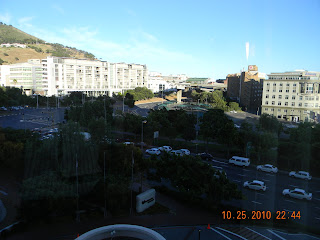Further Lessons from Cape Town...
I took one picture from the window of my hotel room at the Southern Sun Waterfront in Cape Town, South Africa. I looked out that window several times each day. If I had taken the photo a little more to the left, you would have seen Lion's Head... a little more to the right, the giant Waterfront ferris wheel. Either photo would have been more interesting than the one I took. Sometimes, however, the most important things are hidden in the least likely places. As it turns out, this photo holds a lesson that applies in every way to the most important lessons I learned in Cape Town.

I had to crop the picture to see an enlargement of a puzzling structure. A pair of highway bridges that ended right in front of my hotel. According to a tour guide, the bridges have stood unfinished for 40 years... a road to nowhere... I have searched the internet for an explanation, but find only speculation and questions. Did they run out of money? Was it poor planning? One site explained that after the project began, it may have been determined that the elevated road would block the view. Whatever the reason, an enormous amount of money was obviously poured into a project with absolutely no return... ever.

The bridges have taken on new meaning now that I have returned home and to my classroom. They are a symbol for me of what has happened with technology in our district, and I suspect, districts around the country. Our schools have invested a tremendous amount of money into technology. Our district is equipment rich. There are multiple computers in every classroom, mobile and stationary labs, classrooms equipped with Smartboards, projectors, and document cameras. We have the "stuff" and the network to support it. We have the capability to connect our students to the world! All we have to do is cross the bridge. But, at least for the moment, that is a "bridge to nowhere" in many classrooms. Technology is used mostly for email, online games and tests, data collection, and word processing. Why?
The explanation came to me in another lesson from Cape Town. Just outside the modern city filled with beautiful, affluent neighborhoods, you will find sprawling shanty towns.

A tour guide explained to us that the government is trying to create better housing for the residents of the shanty towns, but that many people resist. Moving to the upgraded housing means paying rent and utilities, hard work and added responsibilities. Many would rather stay in the shanties even though moving may bring comfort and advantages to their lives. Even with the opportunity right in front of them, many refuse to change.
It strikes me that there is a comparison to teachers and the journey into 21st century teaching. The tools needed are right at their fingertips, present in the classrooms and throughout the schools. But to use the tools to meet the 21st century demands of communication, collaboration, and creativity as it relates to the global community is hard work and added responsibility. Many would rather stay in their current comfort zone even though moving ahead would bring advantages to their students. Even with the opportunity right in front of them, many refuse to change.
It would be unfair to place all the blame on the teachers, however. There is another lesson to learn from the road to nowhere. Why would a costly project be allowed to be abandoned with no return for the investment? Why was planning not done to see it through? That is again, not unlike technology adoptions in our schools. Money has been spent for equipment. Teams of teachers have been sent to expensive conferences and training. Substitutes have been paid to cover classrooms while selected teachers worked together on developing standards and goals for 21st Century skills. Stipends are paid to a team of teachers to support instructional technology in the classrooms. But the spending and commitment stop there. There is no time during the school day allowed for the other teachers to learn and develop skills. Technology training is expected to take place on a teacher's own unpaid time after school. Less than rarely is inservice or staff development time allocated to technology or 21st century skills. That sends a clear message from the administration to the staff that those things are not important.
We have an opportunity in our district. This year we planned an early release time for students on Friday afternoons to allow for collaborative work among teachers. It is my hope and dream that interested teachers will be allowed to use that paid time to form professional learning communities aimed at increasing innovative teaching strategies in our schools. Teachers are already dealing with more than they can handle, and they are certainly not overpaid professionals. If the money spent on technology is to be more than a "bridge to nowhere", the administration will have to make it a priority. It's time to pay the teachers to complete the bridge! Those in charge will have to communicate the expectation, allow paid time for teachers to develop skills and collaborate, and watch what happens to student motivation and learning when the bridge begins to span the world.